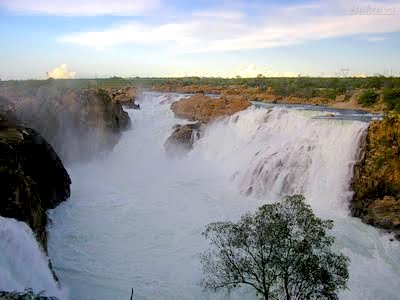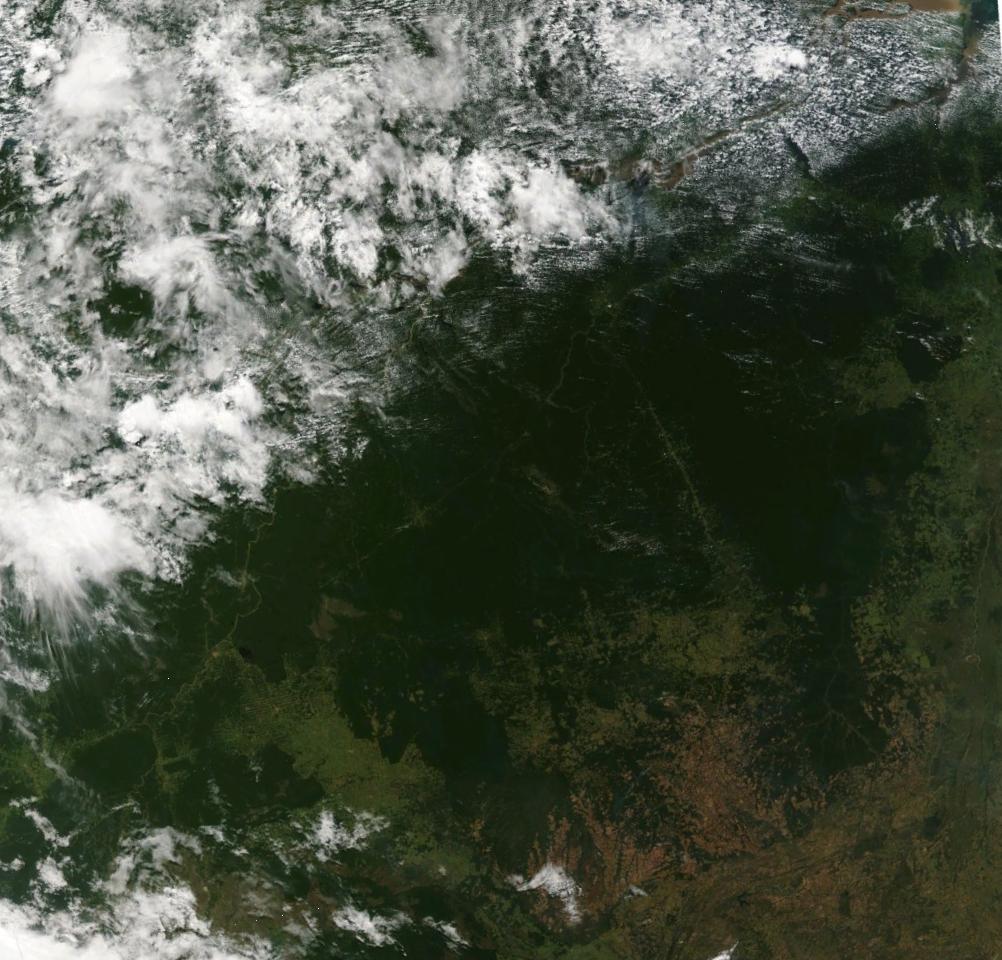|
Tietea Singularis
''Tietea singularis'' was a Marattialean tree fern from the Late Carboniferous to Permian which grew up to in height. It is estimated to represent close to 90% of some fossil assemblages in Brazil. ''Tietea singularis'' stems usually are less than in diameter, bearing four orthostichies of leaves in a decussate arrangement. The stem is surrounded by a continuous ring of sclerenchyma that separates it from the root mantle. ''T. singularis'' stem transverse sections have the same basic structure as Psaronius, but are composed of central vascular bundles having smaller, O- and C-shaped forms, or wavy segments having a short, rounded or fat configuration. Leaf traces are polymeristelic in Tietea, while they are monomeristelic in Psaronius. The Tietea root mantle is composed of polyarch roots embedded in a parenchymatous tissue that is produced both by the stem and the roots. The preserved examples from Pedra do Fogo Formation, in the Maranhão Basin (northeastern Brazil, near Ara ... [...More Info...] [...Related Items...] OR: [Wikipedia] [Google] [Baidu] |
Plantae
Plants are predominantly photosynthetic eukaryotes of the kingdom Plantae. Historically, the plant kingdom encompassed all living things that were not animals, and included algae and fungi; however, all current definitions of Plantae exclude the fungi and some algae, as well as the prokaryotes (the archaea and bacteria). By one definition, plants form the clade Viridiplantae (Latin name for "green plants") which is sister of the Glaucophyta, and consists of the green algae and Embryophyta (land plants). The latter includes the flowering plants, conifers and other gymnosperms, ferns and their allies, hornworts, liverworts, and mosses. Most plants are multicellular organisms. Green plants obtain most of their energy from sunlight via photosynthesis by primary chloroplasts that are derived from endosymbiosis with cyanobacteria. Their chloroplasts contain chlorophylls a and b, which gives them their green color. Some plants are parasitic or mycotrophic and have lost ... [...More Info...] [...Related Items...] OR: [Wikipedia] [Google] [Baidu] |
Conifer
Conifers are a group of cone-bearing seed plants, a subset of gymnosperms. Scientifically, they make up the division Pinophyta (), also known as Coniferophyta () or Coniferae. The division contains a single extant class, Pinopsida. All extant conifers are perennial woody plants with secondary growth. The great majority are trees, though a few are shrubs. Examples include cedars, Douglas-firs, cypresses, firs, junipers, kauri, larches, pines, hemlocks, redwoods, spruces, and yews.Campbell, Reece, "Phylum Coniferophyta". Biology. 7th. 2005. Print. P. 595 As of 1998, the division Pinophyta was estimated to contain eight families, 68 genera, and 629 living species. Although the total number of species is relatively small, conifers are ecologically important. They are the dominant plants over large areas of land, most notably the taiga of the Northern Hemisphere, but also in similar cool climates in mountains further south. Boreal conifers have many wintertime ada ... [...More Info...] [...Related Items...] OR: [Wikipedia] [Google] [Baidu] |
Permian Brazil
The Permian ( ) is a geologic period and stratigraphic system which spans 47 million years from the end of the Carboniferous Period million years ago (Mya), to the beginning of the Triassic Period 251.9 Mya. It is the last period of the Paleozoic Era; the following Triassic Period belongs to the Mesozoic Era. The concept of the Permian was introduced in 1841 by geologist Sir Roderick Murchison, who named it after the region of Perm in Russia. The Permian witnessed the diversification of the two groups of amniotes, the synapsids and the sauropsids ( reptiles). The world at the time was dominated by the supercontinent Pangaea, which had formed due to the collision of Euramerica and Gondwana during the Carboniferous. Pangaea was surrounded by the superocean Panthalassa. The Carboniferous rainforest collapse left behind vast regions of desert within the continental interior. Amniotes, which could better cope with these drier conditions, rose to dominance in place of their amphi ... [...More Info...] [...Related Items...] OR: [Wikipedia] [Google] [Baidu] |
Carboniferous Brazil
The Carboniferous ( ) is a geologic period and system of the Paleozoic that spans 60 million years from the end of the Devonian Period million years ago (Mya), to the beginning of the Permian Period, million years ago. The name ''Carboniferous'' means "coal-bearing", from the Latin '' carbō'' ("coal") and '' ferō'' ("bear, carry"), and refers to the many coal beds formed globally during that time. The first of the modern 'system' names, it was coined by geologists William Conybeare and William Phillips in 1822, based on a study of the British rock succession. The Carboniferous is often treated in North America as two geological periods, the earlier Mississippian and the later Pennsylvanian. Terrestrial animal life was well established by the Carboniferous Period. Tetrapods (four limbed vertebrates), which had originated from lobe-finned fish during the preceding Devonian, became pentadactylous in and diversified during the Carboniferous, including early amphibian lineages ... [...More Info...] [...Related Items...] OR: [Wikipedia] [Google] [Baidu] |
Prehistoric Plants Of South America
Prehistory, also known as pre-literary history, is the period of human history between the use of the first stone tools by hominins 3.3 million years ago and the beginning of recorded history with the invention of writing systems. The use of symbols, marks, and images appears very early among humans, but the earliest known writing systems appeared 5000 years ago. It took thousands of years for writing systems to be widely adopted, with writing spreading to almost all cultures by the 19th century. The end of prehistory therefore came at very different times in different places, and the term is less often used in discussing societies where prehistory ended relatively recently. In the early Bronze Age, Sumer in Mesopotamia, the Indus Valley Civilisation, and ancient Egypt were the first civilizations to develop their own scripts and to keep historical records, with their neighbors following. Most other civilizations reached the end of prehistory during the following Iron Age. Th ... [...More Info...] [...Related Items...] OR: [Wikipedia] [Google] [Baidu] |
Marattiidae
Marattiaceae is the only family of extant (living) ferns in the order Marattiales. In the Pteridophyte Phylogeny Group classification of 2016 (PPG I), Marattiales is the only order in the subclass Marattiidae. The family has six genera and about 110 species. Many are different in appearance from other ferns, having large fronds and fleshy rootstocks. Description The Marattiaceae diverged from other ferns very early in their evolutionary history and are quite different from many plants familiar to people in temperate zones. Many of them have massive, fleshy rootstocks and the largest known fronds of any fern. The Marattiaceae is one of two groups of ferns traditionally known as eusporangiate ferns, meaning that the sporangium is formed from a group of cells as opposed to a leptosporangium in which there is a single initial cell. The large fronds characteristic of the group are most readily found in the genus ''Angiopteris'', native to Australasia, Madagascar and Oceania. These f ... [...More Info...] [...Related Items...] OR: [Wikipedia] [Google] [Baidu] |
Monumento Natural Das Árvores Fossilizadas
The Tocantins Fossil Trees Natural Monument ( pt, Monumento Natural das Árvores Fossilizadas do Tocantins) is a natural monument in the state of Tocantins, Brazil. Location The protection unit was created by law 32.152 on 4 October 2000. It lies with the municipality of Filadélfia, Tocantins. The buffer zone includes the municipality of Babaçulândia. It is administered by the Tocantins Nature Institute (Instituto Natureza do Tocantins). The advisory council includes members of the Tocantins Nature Institute, Federal University of Tocantins, Filadélfia municipality, Bielândia Association of Small Farmers and representatives of local businesses. Most of the visitors to the palaeontological site are groups of high school students or scholars from various parts of the country. The visitor reception centre for the national monument was inaugurated on 2 June 2015 by governor Marcelo Miranda. It had administrative headquarters, bathrooms, male and female quarters, an auditorium ... [...More Info...] [...Related Items...] OR: [Wikipedia] [Google] [Baidu] |
Natural Monument (Brazil)
A Natural Monument ( pt, Monumento natural) in Brazil is a type of protected area of Brazil defined by law. The purpose of a natural monument to conserve unique or very beautiful natural sites. Definition The Natural Monument class of conservation unit was defined by the law 19/93 of 23 January 1993.Decreto-Lei n.º 19/93 de 23-01-1993 Versão: 1 -Artigo 8.º This basic objective of this type of unit is to preserve natural sites that are unique and/or have great scenic beauty. They may be private property as long as the owner's use is compatible with the objectives. If not, the area is expropriated. The public may visit the natural monuments, and research may be conducted with permission of the responsible agency. Selected list Notes Sources * {{authority control Lists of protected areas of Brazil Types of protected area of Brazil ... [...More Info...] [...Related Items...] OR: [Wikipedia] [Google] [Baidu] |
Tocantins
Tocantins () is one of the 26 states of Brazil. It is the newest state, formed in 1988 and encompassing what had formerly been the northern two-fifths of the state of Goiás. Tocantins covers and had an estimated population of 1,496,880 in 2014. Construction of its capital, Palmas, began in 1989; most of the other cities in the state date to the Portuguese colonial period. With the exception of Araguaína, there are few other cities with a significant population in the state. The government has invested in a new capital, a major hydropower dam, railroads and related infrastructure to develop this primarily agricultural area. The state has 0.75% of the Brazilian population and is responsible for 0.5% of the Brazilian GDP. Tocantins has attracted hundreds of thousands of new residents, primarily to Palmas. It is building on its hydropower resources. The Araguaia and Tocantins rivers drain the largest watershed that lies entirely inside Brazilian territory. The Rio Tocanti ... [...More Info...] [...Related Items...] OR: [Wikipedia] [Google] [Baidu] |
Filadélfia, Tocantins
Filadélfia, Tocantins is a municipality in the state of Tocantins in the Northern region of Brazil. The municipality holds the Tocantins Fossil Trees Natural Monument, which preserves one of the largest collections of fossilized Permian trees in the world. See also *List of municipalities in Tocantins This is a list of the municipalities in the state of Tocantins (TO), located in the North Region of Brazil. Tocantins is divided into 139 municipalities, which are grouped into 8 microregions, which are grouped into 2 mesoregions. See al ... References Municipalities in Tocantins {{Tocantins-geo-stub ... [...More Info...] [...Related Items...] OR: [Wikipedia] [Google] [Baidu] |
Parnaíba River
The Parnaíba River ( pt, Rio Parnaíba) is a river in Brazil, which forms the border between the states of Maranhão and Piauí. Its main course is long and the Parnaíba River Basin covers .Ramos, T.P.A.; Ramos, R.T.C.; and Ramos, S.A.Q.A. (2014). Ichthyofauna of the Parnaíba river Basin, Northeastern Brazil.' Biota Neotrop. 14(1). The Parnaíba River rises in the Chapada das Mangabeiras range, and flows northeastward to empty into the Atlantic Ocean, being the longest river entirely located within Brazil's Northeast Region. The middle and upper regions of this river are separated by the pt, Boa Esperança Hydroelectric Power Plant dam, but is otherwise navigable. Ecology The fish species richness in the Parnaíba River Basin has traditionally been considered impoverished, but this has been disproven by recent surveys, which have recorded about 140 native species (including several that remain undescribed) and about 40% of these are endemic. One of the basin endemics is t ... [...More Info...] [...Related Items...] OR: [Wikipedia] [Google] [Baidu] |





